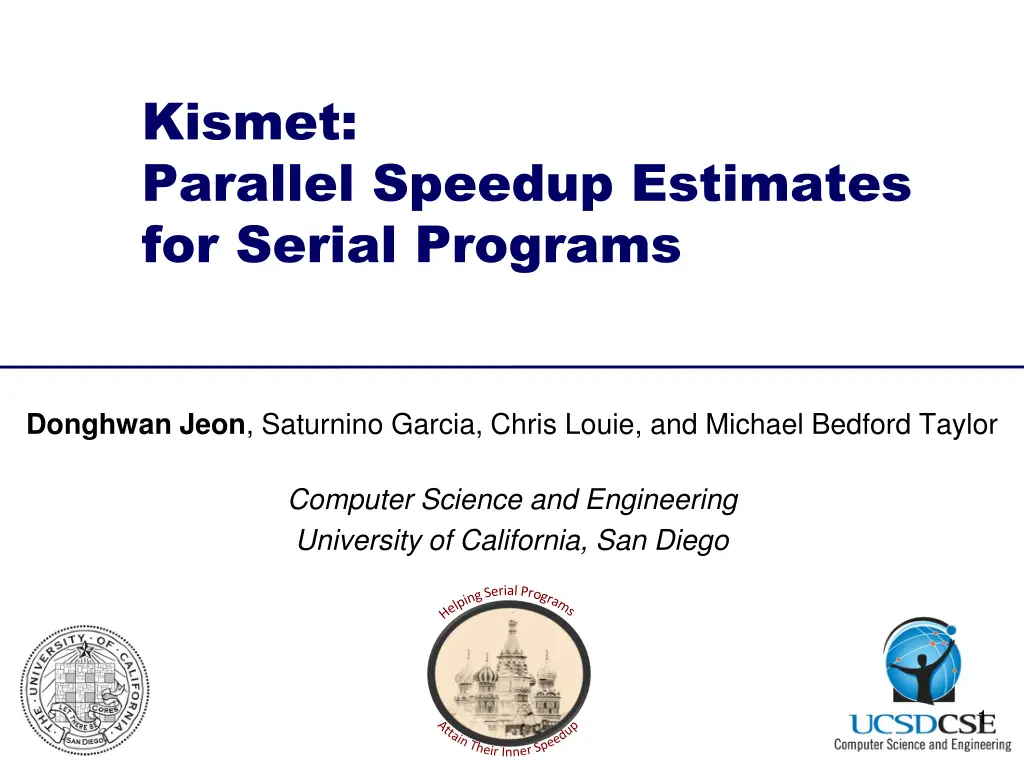
Kismet Parallel Speedup Estimates for Serial Programs
Discover how Kismet automatically provides estimated parallel speedup upper bounds from serial source code, helping optimize performance and achieve efficient parallelization. Learn about critical path analysis, parallelism profiling, and setting performance goals for software engineering projects.
Download Presentation

Please find below an Image/Link to download the presentation.
The content on the website is provided AS IS for your information and personal use only. It may not be sold, licensed, or shared on other websites without obtaining consent from the author. If you encounter any issues during the download, it is possible that the publisher has removed the file from their server.
You are allowed to download the files provided on this website for personal or commercial use, subject to the condition that they are used lawfully. All files are the property of their respective owners.
The content on the website is provided AS IS for your information and personal use only. It may not be sold, licensed, or shared on other websites without obtaining consent from the author.
E N D
Presentation Transcript
Kismet: Parallel Speedup Estimates for Serial Programs Donghwan Jeon, Saturnino Garcia, Chris Louie, and Michael Bedford Taylor Computer Science and Engineering University of California, San Diego HelpingSerialPrograms 1 Attain Their Inner Speedup
Questions in Parallel Software Engineering I heard about these new-fangled multicore chips. How much faster will PowerPoint be with 128 cores? We wasted 3 months for 0.5% parallel speedup. Can t we get parallel performance estimates earlier? How can I set the parallel performance goals for my intern, Asok? Dilbert asked me to achieve 128X speedup. How can I convince him it is impossible without changing the algorithm? 2
Kismet Helps Answer These Questions Kismet automatically provides the estimated parallel speedup upperbound from serial source code. $> make CC=kismet-cc 1. Produce instrumented binary with kismet-cc $> $(PROGRAM) $(INPUT) 2. Perform parallelism profiling with a sample input $> kismet opteron -openmp Cores 1 2 4 8 16 32 Speedup 1 2 3.8 3.8 3.8 3.8 (est.) 3. Estimate speedup under given constraints Kismet s easy-to-use usage model 3
Kismet Overview Kismet Serial Source Code Parallelization Planner Hierarchical Critical Path Analysis Parallelism Profile Find the best parallelization for the target machine Measure parallelism Sample Input Speedup Estimates Parallelization Constraints Kismet extends critical path analysis to incorporate the constraints that affect real-world speedup. 4
Outline Introduction Background: Critical Path Analysis How Kismet Works Experimental Results Conclusion 5
The Promise of Critical Path Analysis (CPA) Definition: program analysis that computes the longest dependence chain in the dynamic execution of a serial program Typical Use: approximate the upperbound on parallel speedup without parallelizing the code Assumes: an ideal execution environment All parallelism exploitable Unlimited cores Zero parallelization overhead 6
How Does CPA Compute Critical Path? la $2, $ADDR load $3, $2(0) addi $4, $2, #4 store $4, $2(4) store $3, $2(8) 7
How Does CPA Compute Critical Path? 1 la $2, $ADDR load $3, $2(0) addi $4, $2, #4 store $4, $2(4) store $3, $2(8) 1 4 1 1 node: dynamic instruction with latency 8
How Does CPA Compute Critical Path? 1 la $2, $ADDR load $3, $2(0) addi $4, $2, #4 store $4, $2(4) store $3, $2(8) 1 4 1 1 node: dynamic instruction with latency edge: dependence between instructions 9
How Does CPA Compute Critical Path? work = 8 1 la $2, $ADDR load $3, $2(0) addi $4, $2, #4 store $4, $2(4) store $3, $2(8) 1 4 1 1 node: dynamic instruction with latency edge: dependence between instructions work: serial execution time, total sum of node weights 10
How Does CPA Compute Critical Path? work = 8 cp = 6 1 la $2, $ADDR load $3, $2(0) addi $4, $2, #4 store $4, $2(4) store $3, $2(8) 1 4 1 1 node: dynamic instruction with latency edge: dependence between instructions work: serial execution time, total sum of node weights critical path length (cp): minimum parallel execution time 11
How Does CPA Compute Critical Path? work = 8 cp = 6 1 la $2, $ADDR load $3, $2(0) addi $4, $2, #4 store $4, $2(4) store $3, $2(8) 1 4 1 1 Total-Parallelism = 1.33 node: dynamic instruction with latency edge: dependence between instructions work: serial execution time, total sum of node weights work Total-Parallelism = critical path length (cp): minimum parallel execution time critical path length 12
Total-Parallelism Metric: Captures the Ideal Speedup of a Program Total-Parallelism Min 1.0 Totally Serial Highly Parallel Most work off the critical path All the work on the critical path 13
Why CPA is a Good Thing Works on original, unmodified serial programs Provides an approximate upperbound in speedup, after applying typical parallelization transformations e.g. loop interchange, loop fusion, index-set splitting, Output is invariant of serial expression of program Reordering of two independent statements does not change parallelism 14
A Brief History of CPA Employed to Characterize Parallelism in Research COMET [Kumar 88]: Fortran statement level Paragraph [Austin 92]: Instruction level Limit studies for ILP-exploiting processors [Wall, Lam 92] Not widely used in programmer-facing parallelization tools 15
Why isnt CPA commonly used in programmer-facing tools? Optimism Ratio Ratio Benchmark CPA Measured Speedup (16 cores) Optimism Estimated Speedup ep life is sp 9722 116278 1300216 189928 3447 648 9228 15.0 12.6 4.4 4.0 3.1 2.1 295503 47482 1112 unstruct sha 2.3 4.8 CPA estimated speedups do not correlate with real-world speedups. 16
CPA Problem #1: Data-flow Style Execution Model Is Unrealistic void inner( ) { . parallel doall for-loop reduction } void middle( ) { . inner(); } void outer( ) { . middle(); } Time Invoke middle Invoke inner Difficult to map this onto von Neumann machine and imperative programming language
CPA Problem #2: Key Parallelization Constraints Are Ignored What type of parallelism is supported by the target platform? e.g. Thread Level (TLP), Data Level (DLP), Instruction Level (ILP) Exploitability Resource Constraints How many cores are available for parallelization? Do overheads eclipse the benefit of the parallelism? e.g. scheduling, communication, synchronization Overhead 18
Outline Introduction Background: Critical Path Analysis How Kismet Works Experimental Results Conclusion 19
Kismet Extends CPA to Provide Practical Speedup Estimates Kismet Hierarchical Critical Path Analysis Parallelization Planner CPA Measure parallelism with a hierarchical region model Find the best parallelization strategy with target constraints 20
Revisiting CPA Problem #1: Data-flow Style Execution Model Is Unrealistic void inner( ) { . parallel doall for-loop reduction } void middle( ) { . inner(); } void top( ) { . middle(); } Time
Hierarchical Critical Path Analysis (HCPA) Step 1. Model a program execution with hierarchical regions Step 2. Recursively apply CPA to each nested region Step 3. Quantify self-parallelism for (i=0 to 4) loop i for (j=0 to 32) foo (); loop j loop k for (k=0 to 2) bar1(); foo() bar1() bar2() bar2(); HCPA Step 1. Hierarchical Region Modeling 22
HCPA Step 2: Recursively Apply CPA Total-Parallelism from inner() = ~7X Total-Parallelism from middle() and inner() = ~6X Total-Parallelism from outer(), middle(), and inner() = ~5X What is a region s parallelism excluding the parallelism from its nested regions?
HCPA: Introducing Self-Parallelism Represents a region s ideal speedup Differentiates a parent s parallelism from its children s Analogous to self-time in serial profilers for (i=0 to 100) { for (i=0 to 100) { a[i] = a[i] + 1; b[i] = b[i] -1; a[i] = a[i] + 1; b[i] = b[i] -1; 200X 2X 100X } } Total-Parallelism (from CPA) Self-Parallelism (from HCPA) 24
HCPA Step 3: Quantifying Self-Parallelism for (i=0 to 100) { for (i=0 to 100) { for (i=0 to 100) { a[i] = a[i] + 1; b[i] = b[i] -1; a[i] = a[i] + 1; b[i] = b[i] -1; a[i] = a[i] + 1; b[i] = b[i] -1; } } } Total-Parallelism(Parent) Self-Parallelism(Parent) Total-Parallelism(Children) Generalized Self-Parallelism Equation 25
Self-Parallelism: Localizing Parallelism to a Region Self-P (inner) = ~7.0 X Self-P (middle) = ~1.0 X Self-P (outer) = ~1.0 X
Classifying Parallelism Type yes ILP yes DOACROSS Leaf Region? yes P Bit == 1? no no DOALL Loop Region? TLP no See our paper for details 27
Why HCPA is an Even Better Thing HCPA: Keeps all the desirable properties of CPA Localizes parallelism to a region via the self-parallelism metric and hierarchical region modeling Facilitates the classification of parallelism Enables more realistic modeling of parallel execution (see next slides) 28
Outline Introduction Background: Critical Path Analysis How Kismet Works HCPA Parallelization Planner Experimental Results Conclusion 29
Revisiting CPA Problem #2: Key Parallelization Constraints Are Ignored What type of parallelism is supported by the target platform? e.g. Thread Level (TLP), Data Level (DLP), Instruction Level (ILP) Exploitability Resource Constraints How many cores are available for parallelization? Do overheads eclipse the benefit of the parallelism? e.g. scheduling, communication, synchronization Overhead 30
Parallelization Planner Overview Goal: Find the speedup upperbound based on the HCPA results and parallelization constraints. region structure self-parallelism Parallel Execution Time Model Parallel Speedup Upperbound Planning Algorithm HCPA profile core count exploitability overhead Constraints Target-dependent parallelization planner 31
Planning Algorithm: Allocates Cores with Key Constraints for (i=0 to 4) loop i self-p=4.0 for (j=0 to 32) loop j foo (); loop j loop k self-p=1.5 self-p=32.0 for (k=0 to 2) bar1(); foo() bar1() self-p=2.0 bar2() self-p=5.0 bar2(); self-p=1.5 A sample core allocation process The allocated core count should not exceed ceil [self-p]. Self-Parallelism If a region s parallelism is not exploitable, do not parallelize the region. Exploitability The product of allocated cores from the root to a leaf should not exceed the total available core count. Core Count 32
Planning Algorithm: Finding the Best Core Allocation Estimate the execution time for each plan and pick the one with the highest speedup. Highest Speedup Plan A Plan B Plan C core: 4X core: 2X core: 2X core: 8X core: 1X core: 4X core: 4X core: 16X core: 16X Core allocation plans for 32 cores How can we evaluate the execution time for a specific core allocation? 33
Parallel Execution Time Model: A Bottom-up Approach Bottom-up evaluation with each region s estimated speedup and parallelization overhead O(R) R is a non-leaf region R is a leaf region loop i speedup=4.0 loop k loop j ptime(loop i) speedup=1.0 ptime (loop k) speedup=4.0 ptime (loop j) foo() bar1() bar2() speedup=1.0 speedup=1.0 speedup=1.0
More Details in the Paper How do we reduce the log file size of HCPA by orders of magnitude? What is the impact of exploitability in speedup estimation? How do we predict superlinear speedup? And many others 35
Outline Introduction Background: Critical Path Analysis How Kismet Works Experimental Results Conclusion 36
Methodology Compare estimated and measured speedup To show Kismet s wide applicability, we targeted two very different platforms Raw Platform Multicore 8 * Quad Core AMD Opteron 8380 Processor 16-core MIT Raw Parallelization Method OpenMP (Manual) RawCC (Automatic) Exploitable Parallelism Loop-Level Parallelism (LLP) Instruction-Level Parallelism (ILP) Synchronization Overhead High Low ( > 10,000 cycles) ( < 100 cycles) 37
Speedup Upperbound Predictions: NAS Parallel Benchmarks 38
Speedup Upperbound Predictions: NAS Parallel Benchmarks Predicting Superlinear Speedup Without Cache Model With Cache Model 39
Speedup Upperbound Predictions: Low-Parallelism SpecInt Benchmarks 40
Conclusion Kismet provides parallel speedup upperbound from serial source code. HCPA profiles self-parallelism using a hierarchical region model and the parallelization planner finds the best parallelization strategy. We demonstrated Kismet s ability to accurately estimate parallel speedup on two different platforms. Kismet will be available for public download in the first quarter of 2012. 41
*** 42
Self-Parallelism for Three Common Loop Types Loop Type DOALL DOACROSS Serial CP CP CP CP Loop s Critical Path Length (cp) CP CP CP CP CP CP (N/2) * CP N * CP Work N * CP N * CP N * CP N * CP N * CP N * CP Self- Parallelism = N = 2.0 = 1.0 CP (N/2) * CP N * CP 43
Raw Platform: Target Instruction-Level Parallelism Exploits ILP in each basic block by executing instructions on multiple cores Leverages a low-latency inter-core network to enable fine-grained parallelization Employs loop unrolling to increase ILP in a basic block RawCC 44
Adapting Kismet to Raw Constraints to filter unprofitable patterns Target only leaf regions as they capture ILP Like RawCC, Kismet performs loop unrolling to increase ILP, possibly bringing superlinear speedup ILP Non-ILP A Greedy Planning Algorithm Greedy algorithm works well as leaf regions will run independent of each other Parallelization overhead limits the optimal core count for each region B C D E F 45
Speedup Upperbound Predictions: Raw Benchmarks 46
Multicore Platform: Target Loop-Level Parallelism Models OpenMP parallelization focusing on loop-level parallelism Disallows nested parallelization due to excessive synchronization overhead via shared memory Models cache effect to incorporate increased cache size from multiple cores 47
Adapting Kismet to Multicore Constraints to filter unprofitable OpenMP usage Target only loop-level parallelism Disallow nested parallelization Bottom-up Dynamic Programming Parallelize either parent region or a set of descendants Save the best parallelization for a region R in Solution(R) Parallelize Descendants Parallelize the Parent A A B C B C Parallelize Don t Parallelize D E F D E F Solution (A) = {A:32} or {C:8, D:32} 48
Impact of Memory System Gather cache miss ratios for different cache sizes Log load / store counts for each region Integrate memory access time in time model 49






















